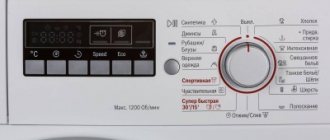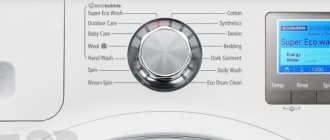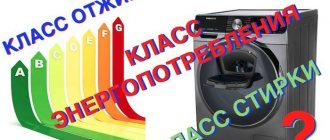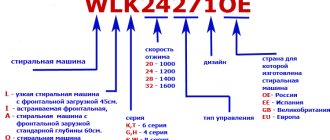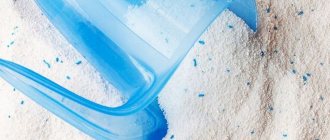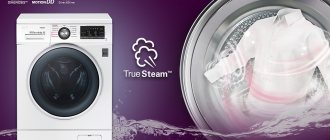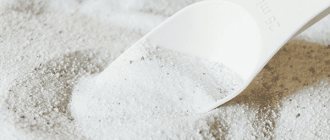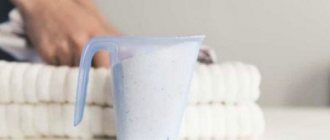When buying a washing machine, you should focus on several basic parameters that determine its class: size and type of load, washing efficiency, spin type and energy efficiency. Knowledge about each of these criteria will ultimately help you choose the optimal model that will serve its owner for many years and will suit him not only visually, but also technically.
- Generally accepted classification
- Why do they give an "A" grade?
- Washing class
- Spin class
- Energy class
- Types by size and loading
- Is drying necessary?
- Additional functions
- What to look for when purchasing
- Catalog of washing machines with reviews
Generally accepted classification
Are you using citric acid?
Oh yes! No
You can understand the quality of the washing machine in front of you by focusing on a special classification developed by European countries. Models of this type of household appliances are evaluated according to three main indicators: energy consumption, washing quality and spin performance.
In all of these parameters there is a gradation by class, where “A” is the highest grade and “G” is the lowest. Each vehicle parameter is assigned 7 ratings:
- “A” and “B” are excellent and good grades, respectively;
- “B” and “C” – very good and not bad;
- “D” and “E” – normal and satisfactory;
- "F" and "G" are bad and very bad.
General classification
It turns out that any machine will receive at least three ratings. The latest options are practically not produced, and it is also unlikely that anyone would want to purchase equipment that is already known to be ineffective. But if, nevertheless, such a model is found on the consumer market, then there is no need to buy it.
It is worth paying attention to the fact that the classification system is only a basis that changes and is modernized over time. Thus, depending on the parameter of energy efficiency and washing, new classes have appeared: “A+”, “A++” and also “A+++”.
Help: determining the class of the selected model is not difficult even for a beginner - this data is located on a special sticker on the body of the machine. Usually the manufacturer does not hide them, but on the contrary, makes them most noticeable.
What will European indices tell you?
First of all, you should understand what the spin class in washing machines is. This is considered to be one of the most important parameters for evaluating modern models. It characterizes the percentage of moisture remaining in washed items. This indicator depends on the number of drum revolutions per second - the higher the speed, the drier the things.
To calculate the effectiveness of this process at home, you need to weigh the wrung out laundry, dry it and weigh it again. Then you should make a simple calculation: subtract the weight of the dried laundry from the weight of the wet, divide the result by the weight of the dry items and multiply by 100%.
For example, after washing you weighed the laundry, it turned out to be 5 kg. After drying, its weight decreased to 3 kg. As a result of subtraction, we get the number 2. Divide it by 3 - it comes out to 0.66. We multiply the fraction by 100% - it turns out that the percentage of humidity is 66%.
Spin efficiency classes
Fortunately, when purchasing equipment in a store, you don’t have to count anything yourself. The spin class of the washing machine is usually indicated in the documentation for the model. It is classified by indices from A to G. This is a European quality standard for drying clothes, which is accepted throughout the world. Each indicator indicates how dry your items will be after finishing washing. Let's take a closer look at the classification:
- G – the percentage of moisture after spinning is above 90%. In such units, the laundry will be only 10% dry at the exit. Number of drum revolutions per minute – 400;
- F – assumes a spin efficiency of 81-90% at a speed of 600 rpm;
- E – percentage of moisture remaining after washing – 72-81%. The equipment of this class will “scroll” the laundry at a speed of 800 revolutions per minute;
- D – 63-72% moisture will remain in things. Speed – 1000 rpm;
- C – will provide spin efficiency of 54-63%. In this case, the drum will spin at a speed of 1200 rpm;
- B – the washing machine spins the laundry at a speed of 1400 rpm, leaving no more than 45-54% moisture in it;
- A – provides the driest spin – no more than 45% moisture remains in things. Speed –1600 rpm.
Why do they give an "A" grade?
For any of the parameters (washing efficiency, spinning and energy consumption), a rating of “A” or “very good” is top notch. It is placed if the SMA performs the specified function at a high level:
- Washing class “A” is assigned if the machine removes all stains and is as efficient as possible.
- Spin class “A” is assigned depending on the residual moisture content of the laundry (in this case it should not exceed 45%).
- In terms of energy efficiency, the most economical washing machine in terms of energy consumption receives an “A” rating.
Class A+++
Parameter characteristics
The washing result is measured by a parameter called class.
And this raises a lot of questions for many people. Washing class A - what does it mean and what parameters is it responsible for? Technically, he is responsible for the quality of the washing process. The parameter depends on the composition and structure of the items involved in the washing process. Of course, the value of this parameter will vary, since items or fabrics of the same quality will have different degrees of washing in the same machine. This result is influenced by various factors, including the type and quality of the detergent, temperature and water parameters, etc.
Therefore, testing is carried out to determine the index. For this, the reference washing method is used: to calculate the parameter using this method, a reference machine and a testing machine are used. Both are loaded with fabrics of the same size, with similar degrees of contamination.
Next, wash with the same temperature (60 degrees) and test time (60 minutes). The quality of the washed fabric is compared with the reference sample. If the test result exceeds the standard one, the machine is assigned a class, designated by index A. It is the highest and shows the maximum degree of washing efficiency. By purchasing a unit with this index, you can be sure of the cleanliness of the cleaned laundry.
Manufacturer data
Washing cotton
Noise, spinning, loading
| Name | Spin max. (rpm) | Case depth (cm) | Max. water heating (⁰С) | Program Cotton 60⁰С (hour:min / energy kW / water l) | Cotton program 40⁰С (hour:min / energy kW / water l) | Hatch opening diameter (cm) | Spin efficiency (% fabric weight gain*) | Noise dB(A) Leq |
| Samsung WW70J4210JW | 1200 | 45 | 95 | 2:34 / 1,36 / 62 | 3:15 / 0,62 / 54 | 30,5 | 45 | 61,2 |
| Samsung WF90F5E5U4W | 1400 | 55 | 95 | 2:25 / 1,55 / 83 | 2:59 / 0,95 / 82 | 31 | 43 | 61,2 |
| Samsung WW90J6410CW | 1400 | 55 | 95 | 2:24 / 1,36 / 85 | 3:23 / 0,95 / 89 | 31,3 | 41 | 63,7 |
| Samsung WF1802XEY | 1200 | 45 | 95 | 2:01 / 0,82 / 76 | 2:26 / 0,81 / 73 | 31 | 56 | 59,9 |
| Samsung WW90K6414SW | 1400 | 55 | 95 | 2:26 / 1,31 / 87 | 3:23 / 0,99 / 90 | 31,2 | 42 | 61,7 |
Washing class
One of the main functions of a washing machine is to combat stains on fabric. The efficiency indicator for this parameter just demonstrates the washing class. There is also a generally accepted gradation from “A” (washing is very good) to level “G” (very weak).
A completely logical question arises: why is this or that technique awarded a certain class? Naturally, it is possible to determine how well SMA erases only under experimental conditions. IN
As a starting point, a standard machine is taken, which copes with this no better or worse than others, but always shows a constant result. Under the same conditions, on the same piece of fabric, a test is carried out, based on the results of which a verdict is made:
- The highest score, or “A” rating, is given to a machine whose washing class is defined as excellent (its efficiency index is 1.3).
- Very good wash o (index – from 1 to 1.3).
- A good wash is assigned class “C” (index – from 0.97 to 1).
- Normal is designated by the letter “D” (index – from 0.94 to 0.97).
- Satisfactory is “E” (index – 0.91 to 0.94).
- The bad one gets o (index – from 0.88 to 0.91).
- Very poor washing o (index – 0.88-0).
Expert opinion
I work in the household appliance repair industry. Extensive experience in restoring washing machines and dishwashers.
Ask a Question
Important! Today, manufacturers have begun to produce a new generation of washing equipment with a washing class of “A+” and higher, however, their price can be much more expensive. But is such a machine worth the money? Practice shows that in the issue of washing efficiency, not only the machine itself plays an important role, but also the cleaning agent and the nature of the contamination. That is, you can simply use a good powder - and equipment with class “C” will cope with stains on clothes no worse than machines marked with the signs “A” and “B”. That is, this factor matters, but there is no need to chase the highest rating and overpay.
About the reference SMA
The reference machine was released in 1995. Nowadays, standards can only be obtained by authorized manufacturing plants. Their effectiveness is undeniable. But be careful: due to the rapid development of modern technologies, a regular machine can wash much better than a standard one. Remember that the benchmark shows a stable result, not the best. She simply recorded the lowest dispersion in indicators. That is, 10 out of 10 washes are approximately the same in quality, while in a non-reference model for 10 washes 1-2 will be of low efficiency, and the rest will have excellent performance.
Spin class
An important parameter for washing equipment is the spin class. It shows as a percentage how wet your items will be after washing. This indicator directly depends on the number of revolutions of the machine per minute. That is, the more often the drum rotates, the drier things will be.
The percentage of humidity can be easily calculated - it is the ratio of the weight of the laundry before and after the washing process. Depending on the spin class, washing machines are assigned ratings from “A” to “G”, each of them corresponds to a certain humidity and speed:
- The best spin quality is marked with the letter “A”, with which the residual moisture content of the laundry will be less than 45%.
- The “B” value indicates that after spinning the fabric will remain 45-54% damp.
Do you wash by hand?Oh yes! No
- “C” means that the technique will spin the laundry, leaving it at 54-63%.
- A value of 63-72% guarantees class “D”.
- “E” means that after washing the items will be 72-81% damp.
- “F” corresponds to a result of 81-90%.
- A machine with class “G” after washing will show the laundry humidity to be more than 90%.
In addition, the spin efficiency depends on the diameter of the drum and the time it takes to complete the full spin cycle. The longer the time and the larger the drum, the drier the laundry will be.
The dryness of the fabric is also affected by the permeability of the material. So, a chiffon blouse and jeans after washing together will have a different percentage of moisture.
Important! A higher spin class is not always good. Strong - will deform the fabric. Obviously, for regular washing of ordinary and delicate materials, class “D” is quite suitable. It is believed that machines with 1000 - 1200 drum revolutions per minute are suitable for any laundry.
Most modern washing machines have several spin modes programmed into them; this is also worth paying attention to when purchasing.
Proportion of dry fabric depending on class
At what temperature to wash bed linen, how to choose the right mode
When choosing a washing program, you need to consider the type of fabric. For example, synthetics and satin made from silk and cotton threads must be washed at different temperatures. The duration of washing and the number of rotations of the drum during spinning may also differ, since the fabrics have a different structure. Modern washing machines from brands Bosch, LG, Siemens, Samsung and others have an impressive range of washing programs in their arsenal.
Each washing machine has modes for washing items made from cotton, synthetics, wool
What mode should I use to wash bed linen made from different fabrics? Next, we will talk about the temperature suitable for washing each of the common materials.
Cotton fabric
The optimal washing temperature is +60 ℃. It is better to wash heavily soiled white laundry at +90 ℃ using bleaching powder. Colored bed linen is washed at a water temperature of +40...50 ℃, using powders and liquid detergents intended for colored fabrics. If there are stains on the fabric, it is better to pre-soak the set.
Children's bedding is washed at a temperature not lower than +60 ℃
It is better to wash dirty children's bedding at elevated temperatures, at least +60 ℃, even if they are colored. If the degree of pollution is low, you can lower the temperature to +40 ℃.
Do not get carried away with washing at high temperatures - this leads to premature wear of the fabric
The fabric should be ironed from the front side, and it is recommended to moisten it. It is best to dry in a well-ventilated area. Colored linen should not be hung in the sun, as the dye may fade.
Silk
Silk fabric has a delicate structure, so to wash it you need to use a manual or delicate cycle. You need to wash bed linen in a washing machine at a water temperature not exceeding +30 ℃. Spinning at high speeds can damage delicate fabric, so it is better to turn it off altogether. It is advisable to use a special detergent designed for silk and wool fabrics.
You should dry your clothes in the shade, avoiding sunlight and the proximity of heating devices. Iron only from the wrong side, at low temperatures. Humidification and steam treatment will damage the fabric, so do not use them.
Silk bed linen promotes good rest, as it is extremely soft and gentle to the touch.
Linen fabric
Linen is a natural material. Bed linen made from this fabric is practical and very popular. Contaminated fabric can be washed well at a temperature of +90 ℃; the material is not afraid of high temperatures. How many degrees should you choose for the optimal washing mode? The same as for cotton: +60 ℃, - in this case, it is best to select the “Cotton” mode in the SM.
Linen bed linen
For products with colored patterns, the recommended temperature is +40 ℃. Linen products can be washed well if you pre-soak them in warm water with dissolved laundry soap. The fabric should not be dried near heat sources, as this will cause the material to shrink. Linen should be ironed at maximum temperature, the fabric should be damp.
Satin
The material contains cotton, so it is washed in the same way as cotton fabric. The optimal temperature is +60 ℃, while an increase to +90 ℃ is allowed for heavily soiled fabrics. It is better to spin the laundry at a medium number of drum revolutions, but this can also be done at the maximum permissible speed.
Synthetic fabrics
Underwear is also made from synthetic material, although doctors do not recommend using it. People buy such products because of the lower price. Synthetics are afraid of high temperatures, so for washing such sets a temperature not exceeding +40 ℃ is suitable. Washing machines usually have a “Synthetics” program that automatically selects the temperature and cycle duration. Such items should not be dried near heat sources or ironed.
Synthetic bedding is not good for human health
Energy class
A good washing machine should be economical in energy consumption. The corresponding marking will show how energy-saving it will be:
- “A+” (newest generation) – electricity consumption – 0.17 kW/h.
- Class “A” shows that the machine will consume from 0.17 to 0.19 kW/h.
- In the case of “B”, electricity consumption will range from 0.19 to 0.23 kW/h.
- Class “C” consumption will be from 0.23 to 0.27 kW/h.
- A machine marked “D” will consume between 0.27 and 0.31 kWh.
- Equipment marked “E” will consume from 0.31 to 0.35 kW/h.
- Class “F” washing machine – from 0.35 to 0.39 kW/h.
- The most expensive will be “G” - from 0.39 kW/h.
Expert opinion
I work in the household appliance repair industry. Extensive experience in restoring washing machines and dishwashers.
Ask a Question
Important! The energy consumption class is indicated per kilogram of items. Therefore, in order to calculate the exact value of electricity consumed per wash, you need to multiply the indicated number by the weight of the laundry.
Competition in the car market today is great and manufacturers fight for buyers by constantly modernizing them. The usual classification of cars from seven ratings (“A” – “G”) has long included equipment with the “A+” sign. But the leaders in the production of washing machines do not stop there - in retail chains you can increasingly find models of a higher class.
Example of a tag on a car
Dishwashers
In the case of dishwashers, energy efficiency is calculated based on the number of items. Thus, according to the EU directive, the class determines the number of kWh spent on washing 12 items in one cycle. Below are tabular data:
| A | B | C | D | E | F | G |
| <1,06 | <1,25 | <1,45 | <1,65 | <1,85 | <2,05 | >2,05 |
Types by size and loading
Based on the type of loading, machines are divided into frontal and vertical. Frontal ones can most often be found in retail chains - this is a familiar technique with a transparent round-shaped door, reminiscent of a porthole. In a top-loading machine, laundry is placed through a special opening at the top.
There is no significant difference in these two models, except for the location of bearings and dimensions. Here everyone finds what is closest to them.
The size is chosen, usually based on the size of the bathroom and washing needs:
- A machine with a width of 32-35 cm and a load of 3 to 4 kg will fit perfectly even in a small room and is suitable for a family of two. Unfortunately, you cannot wash a down jacket or blanket in it.
- Larger equipment with a capacity of 5 to 6 kg and a width of 40-45 cm can easily cope with washing a large item. Accordingly, it is suitable for serving a family of 3-4 people.
Do you wash your shoes in the machine?
Oh yes! No
How much does laundry weigh?
Now it’s logical to talk about how much laundry you can wash in a machine in one wash without weighing it. Each piece of clothing has its own weight in grams, for example, a women's T-shirt can weigh on average from 70 to 140 grams, depending on the size. A few more similar examples are reflected in the table below. Using a table like this you can easily calculate how much laundry to put in the drum.
In a machine with a 5 kg load, at any mode for cotton fabrics, you can wash a couple of sheets, a couple of pillowcases and 3-4 towels. The laundry will rotate freely in the drum without twisting or wrinkling. But outer clothing needs to be washed separately.
Modern washing machines have an “Auto-weighing” function. Now a person does not need to think about how much the dirty laundry he loads weighs; the machine will receive the necessary information itself. The main benefit of the function is that the machine, having recognized the weight of the laundry, will determine the amount of water required for washing and select the optimal washing program. This results in a triple benefit:
- the machine eliminates the need to think about how much laundry to put in;
- saves water and electricity;
- selects the best program to wash your laundry properly.
Auto-weighing also protects the washing machine from breakdowns, since overload can lead to drum imbalance. If the machine has automatic weighing, then if the drum is overloaded, it simply will not start and will give an error.
Thus, it is necessary to put laundry into the drum of a washing machine not in accordance with the maximum load of the machine, but in accordance with the maximum load for a certain washing mode. We hope our article helped you understand how much stuff to put in a drum. Good luck!
Is drying necessary?
There are times when there is no time or opportunity to dry laundry. And here a machine with a drying function comes to the rescue: after such washing, the items are removed completely dry, without requiring hanging.
But this function also has a number of disadvantages:
- rarely found in washing machines;
- significantly increases the cost (from 20%);
- often dries out laundry.
Efficiency classes
Conclusion
The energy efficiency class is only an average indicator of how much electricity a particular device will consume. Much depends on the conditions and time of operation. If you are an ordinary consumer and are buying a washing machine or air conditioner for yourself, then you shouldn’t pay much attention to the energy efficiency class. It’s easier and more effective to save by switching to a multi-tariff electricity payment system. If you have a private laundry and washing machines will work around the clock, then it is better to purchase devices of at least A+ class.
Additional functions
Often, equipment sellers try to attract the buyer by listing additional functions of the machine. But what are they and what are they for?
“Quick wash” is the best solution for those who urgently need clean laundry. The cycle in this case lasts from 15 to 30 minutes.
“Delayed start” - a function that helps the car owner save energy. For example, washing starts at night and consumes energy at reduced rates. Or the owner of the equipment simply needs dry laundry at a certain point. You can delay washing from 1 to 24 hours.
“Pre-wash” allows you to remove even stubborn stains. With this function, the laundry is soaked, and then the main cycle is turned on.
“Bio-washing” is a kind of stain removal stage. Before washing, the machine keeps the temperature around 30-40 degrees Celsius so that special granules - enzymes contained in the powder - corrode the dirt.
“Protection against leaks” or “AquaStop” function protects the machine from water leakage after washing. Can be used using: thickened inlet hose, solenoid valve, drip tray. It can be complete or partial.
Are you unplugging your washing machine?
Oh yes! No
Main programs
Different manufacturers equip their equipment with a different set of modes and programs. However, all devices have categories of modes:
- programs that regulate washing parameters based on the type of laundry or fabric;
- economical modes to reduce cycle time. As a result, water and electricity consumption is reduced;
- options for health care: for allergy sufferers, disinfection and others.
Cotton (linen)
The program is designed for heavily soiled cotton and linen items and bedding.
You can set 4 modes: 30, 40, 60, 90-95 degrees. For example, white linen can be washed at maximum temperature, but colored items should not be exposed to temperatures above 40 degrees, as they are susceptible to color fading.
The longest mode involves 4 rinses in cold water, because natural dense fabrics actively absorb water, and the powder from them is difficult to rinse out.
The longest mode consists of 4 rinse cycles, since cotton laundry absorbs moisture more quickly and powder is washed out of it more slowly. Rinse things with cold water. This type of laundry is spun at maximum speed for a washing machine.
Synthetics
The mode is intended for synthetic and mixed items at 60 degrees. Items take a long time to wash, several rinses are provided, and spinning is performed at high speeds.
Wool
Modern technology allows you to carefully wash even items made of wool and cashmere. A small amount of water is drawn into the drum and it swings slightly. Thanks to the features of the program, pills do not appear on things and they do not shrink.
Silk
Delicate program for washing natural silk, viscose and lace. The program provides for a short rotation of the drum, after which it waits. Things are rinsed with a lot of water and cannot be wrung out.
It is better to entrust the repair of washing machines to professionals!!!
We present to you our unique catalog of private masters and service centers - BigWash.ru
Select your city and artist in the filter: by rating, reviews, price!
The number of revolutions at the end of the cycle is no higher than 600 revolutions.
Jeans and sportswear
Initially, the prewash begins at a low temperature. Manufacturers recommend using biopowders for this program, which carefully and deeply remove complex stubborn stains. You can wash sports fabric shoes on this cycle, but you should only load one pair.
Intensive
The program is suitable for heavily soiled and stained items; it has a temperature of 90 degrees and an extended cycle time. Not recommended for delicate fabrics.
Down jackets
Program for washing down jackets and outerwear in general. Typically, the temperature of this program does not exceed 30-40 degrees. Find out how to properly wash a down jacket in a washing machine from our separate article.
Baby clothes
Thanks to the high temperature and additional rinsing, it thoroughly washes baby clothes and rinses out the powder.
Handwash
The drum turns at low speed and turns gently, the temperature is 30-40 degrees. No spin is performed. Used for delicate items that cannot be stretched to avoid deformation of the product.
Eco mode
ECO programs provide low temperatures, which makes it possible to save up to 40% of energy per wash cycle. The time-saving program allows you to halve the cycle duration, while the quality of the wash does not suffer. The wash lasts 20-30 minutes and is suitable for lightly soiled items.
Prewash
The program starts before the main wash cycle. The powder must be poured into two containers at the same time. The first cycle is provided at 40-50 degrees, after which the standard cycle is carried out.
Soak
Linen is soaked in water at 30 degrees, the time varies depending on the manufacturer. The longest process is provided by the equipment of the manufacturers Gorenje and Electrolux.
What to look for when purchasing
In such a serious matter as choosing a washing machine, you simply need to pay attention to its washing class. But it is not necessary to look for equipment with an “AAA” rating.
For example, in terms of wash quality, you may not even feel any difference between the “A” and “B” ratings. Spin level “C” is quite suitable for weekly laundry care.
The most important parameter, perhaps, remains the energy consumption class. But even in this case, even an indicator at level “A” or “B” will indicate the efficiency of the equipment.
Video
All other factors are selected individually and calculated based on the budget.
Which brand should you prefer?
Having decided on the functionality that you really need, proceed to solving an equally difficult task - choosing a device brand. How to choose the right washing machine from the manufacturer’s point of view? Even experts do not undertake to definitively answer the question of which brand makes the best washing machines. Any brand of equipment has both pros and cons.
Such popular brands of washing machines as LG, Beko, Indesit, Samsung, Hotpoint Ariston, Candy, Whirpool, Gorenje, Zanussi, Atlant are famous for their fairly good quality and decent functionality. These manufacturers often top sales rankings, because they produce a wide range of equipment designed to suit every taste and budget. The cost varies depending on the set of functions, so the buyer can choose a model in both the budget and mid- or high-price segments.
Some manufacturers lure buyers by offering good service support.
The most popular brands in terms of price and quality ratio are Siemens, Bosch, Electrolux, AEG, Hitachi. The cost of such washing machines may differ markedly from units of the previous category, but this is justified by maximum reliability. Manufacturers focus on high quality assembly and materials, and also offer a large selection of models, including budget lines of washing machines.
Bosch washing machines have long won the trust of consumersIt would not be amiss to mention the manufacturers of luxury equipment - Miele, Smeg, Asko, Schulthess. The products of these brands are expensive, but they are of high quality and can last more than 15-20 years. It is usually purchased for professional use, for example, in laundries. Also, the buyer has to overpay for the exclusive design of devices that some brands offer.
What criteria are used to determine the best household appliances?
If you look at the ratings of automatic washing machines, you will notice that they differ from each other. This happens because users and experts in their assessments give preference to one or more features that are most important to them. AFM is assessed according to the following criteria:
- design features;
- reliability and durability;
- noise level and washing quality;
- dimensions and maximum weight of loaded laundry;
- washing and spinning class;
- energy consumption class;
- price category.
It is quite difficult to determine which washing machine is better based on the combination of the above indicators.
If we take into account the design features and price factor, then automatic front-loading units are the most common among users. Top-loading machines are less popular among housewives
AFMs differ from each other in size. A small family living in a small apartment will prefer a narrow unit that can hold up to 4 kg of laundry. Medium depth machines are capable of washing from 5 to 7 kg of clothes at a time. Full-size models can wash even more – up to 13 kg.
Budget models from well-known manufacturers are of great interest to buyers. Among them are the best washing machines, which are not inferior in quality to more expensive competitors.
